Bob Batchelor's Blog, page 12
May 1, 2017
Stan Lee’s First Publication – Captain America Comics #3 (1941)
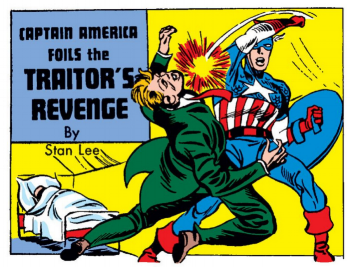
Stan Lee writes Captain America story, first publication for Marvel
Joe Simon needed copy and he needed it fast!
The Timely Comics editorial director and his coworker and friend Jack Kirby were hard at work on the hit they had recently launched – the red, white, and blue hero Captain America. Readers loved the character and Simon and Kirby scrambled to meet the demand.
The duo brought in some freelancers to keep up. Then they threw some odd copy-filler stories to their young apprentice/office boy Stanley Lieber as a kind of test run to see if the kid had any talent. He had been asking to write and the short story would be his on-the-job audition.
The throwaway story that Simon and Kirby had the teenager write for Captain America Comics #3 (May 1941) was titled: “Captain America Foils the Traitor’s Revenge.” The story also launched Lieber’s new identity as “Stan Lee,” the pseudonym he adopted in hopes of saving his real name for the future novel he might write.
Given the publication schedule, the latest the teen could have written the story is around February 1941, but he probably wrote it earlier. The date is important, because it speaks to Lieber’s career development. If he joined the company in late 1939, just after Kirby and Simon and when they were hard at work in developing Captain America, then there probably wasn’t much writing for him to do. However, if the more likely time frame of late 1940 is accepted, then Lieber was put to work as a writer fairly quickly, probably because of the chaos Simon and Kirby faced in prepping issues of Captain America and their other early creations, as well as editing and overseeing the Human Torch and Sub-Mariner efforts.
Lee later acknowledged in his autobiography that the two-page story was just a fill-in so that the comic book could “qualify for the post office’s cheap magazine rate.” He also admitted, “Nobody ever took the time to read them, but I didn’t care. I had become a published author. I was a pro!” Simon appreciated the teen’s enthusiasm and his diligence in attacking the assignment.
An action shot of Captain America knocking a man silly accompanied Lieber’s first publication for Simon and Kirby. The story – essentially two pages of solid text – arrived sandwiched between a Captain America tale about a demonic killer on the loose in Hollywood and another featuring a giant Nazi strongman and another murderer who kills people when dressed up in a butterfly costume. “It gave me a feeling of grandeur,” Lee recalled at the 1975 San Diego Comic-Con.
While many readers may have overlooked the text at the time, its cadence and style is a rough version of the mix of bravado, high-spirited language, and witty wordplay that marked the young man’s writing later in his career.
Lou Haines, the story’s villain, is sufficiently evil, although we never do find out what he did to earn the “traitor” moniker. In typical Lee fashion, the villain snarls at Colonel Stevens, the base commander: “But let me warn you now, you ain’t seen the last of me! I’ll get even somehow. Mark my words, you’ll pay for this!”
In hand-to-hand combat with the evildoer, Captain America lands a crippling blow, just as the reader thinks the hero may be doomed. “No human being could have stood that blow,” the teen wrote. “Haines instantly relaxed his grip and sank to the floor – unconscious!” (Captain America Comics #3, p. 37) The next day when the colonel asked Steve Rogers if he heard anything the night before, Rogers claims that he slept through the hullabaloo. Stevens, Rogers, and sidekick Bucky shared in a hearty laugh.
The “Traitor” story certainly doesn’t exude Lee’s later confidence and knowing wink at the reader, but it clearly demonstrates his blossoming understanding of audience, style, and pace.
Both “Stan Lee” and a career were launched!
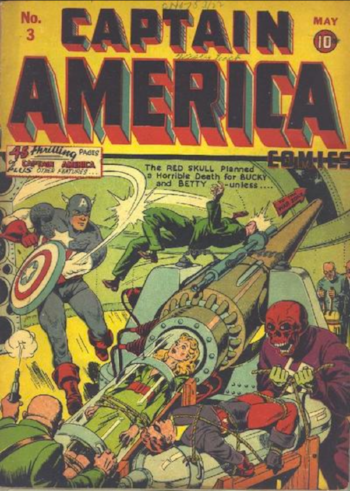
Cover of Captain America #3, Stan Lee's first writing credit for Marvel in 1941
April 28, 2017
Stan Lee Sues Marvel…And Wins!

New York Times headline; Stan Lee and Marvel settle lawsuit
In a tale filled with greed, envy, unfulfilled promises, and years of legal scheming, Marvel announced a financial settlement on April 28, 2005, with its most famous employee – comic book legend Stan Lee.
Filed under the heading, “Things No One Ever Expected,” Lee had sued Marvel three years earlier for not fulfilling the terms of his employment contract. The subsequent legal maneuvering created a tense situation for Lee and a public relations headache for the company he had helped build.
The beguiling battle began in late October 2002, when the popular CBS news program 60 Minutes II aired a segment about the state of comic books and the tremendous popularity of superhero films. The report also examined Lee’s potential skirmish with Marvel regarding language in his contract, specifically certain payments Lee justly deserved based on the surging box office returns of Marvel films after decades of mediocre efforts and failed attempts at bringing the company’s superheroes to the screen.
The new program painted Marvel in an evil light – a greedy corporation making insane amounts of money off the backs of its writers and artists. Lee’s 1998 contract seemed straightforward, but when it was inked no one expected the future to include such wildly successful films – X-Men (2000) earned nearly $300 million worldwide, while Spider-Man (2002) became a global phenomenon, drawing some $821 million.
60 Minutes II correspondent Bob Simon, using a bit of spicy language that seemed uncharacteristic for the venerable CBS show, actually asked Lee if he felt “screwed” by Marvel. Lee toned down his usual bombast though and displayed remorse for having to sue his employer, a situation that he explained “I try not to think of it.” As a result, many Marvel fans sided with Lee in the dispute.
Mere days after the segment aired, Lee sued Marvel for not honoring a stipulation that promised to pay him 10 percent of the profits from Marvel Enterprise film and television productions. Despite his $1 million annual salary as chairman emeritus, Lee’s attorney’s argued that the provision be honored. The grand battle between Marvel and its most famous employee shocked observers and sparked news headlines around the globe. Summing up the public’s general feeling about the controversy, Brent Staples of the New York Times explained: “You can’t blame the pitchman for standing firm and insisting on his due.”
The public nature of the contract and its terms (including his hefty salary for a mere 15 hours of work each week, guaranteed first-class travel, and hefty pension payouts to Lee’s wife Joanie and daughter J.C.) led some comic book insiders to once again dredge up the argument regarding how the comic book artists and co-creators – most notably Jack Kirby – were treated by Marvel (and by extension Lee). Rehashing this notion and the idea that Lee attempted to capitalize off the success of the films turned some people against him. To critics, Lee got rich, while Kirby and others didn’t. The injustice had been done and they weren’t going to change their opinions, regardless of what Lee’s contract stipulated
In early 2005, after the judge presiding over the case ruled in Lee’s favor, he again appeared on 60 Minutes. “It was very emotional,” said Lee. “I guess what happened was I was really hurt. We had always had this great relationship, the company and me. I felt I was a part of it.” Despite the high profile nature of the lawsuit and its apparent newsworthiness, Marvel attempted to bury the settlement agreement with Lee in a quarterly earnings press release.
In April 2005, Marvel announced that it had settled with Lee, suggesting that the payoff cost the company $10 million. Of course, the idea that Lee had to sue the company that he spent his life working for and crisscrossing the globe promoting gave journalists the attention-grabbing headline they needed. And, while the settlement amount seemed grandiose, it was a pittance from the first Spider-Man film alone, which netted Marvel some $150 million in merchandising and licensing fees.
Despite the financial loss, the lawsuit resulted in an unexpected upside for Marvel. The settlement put in motion plans for the company to produce its own movies, a major shift in policy. Since the early 1960s, Marvel and its predecessor companies had licensed its superheroes to other production companies. Back then, the strategy allowed Marvel to outsource the risk involved with making television shows and films, but also severely hindered it from profiting from the creations. This move gave Marvel control, not only of the films themselves, but the future cable television and video products that would generate revenues.
Merrill Lynch & Co extended a $525 million credit line for Marvel to launch the venture (using limited rights to 10 Marvel characters as collateral), and Paramount Pictures signed an eight-year deal to distribute up to 10 films, including fronting marketing and advertising costs.
Interestingly, the details of the settlement between Lee and his lifelong employer shed light on suspect Hollywood accounting practices that film companies use to artificially reduce profitability. For example, for all the successes Marvel films had in the early 2000s, raking in some $2 billion in revenues between 2000-2005, Marvel’s cut for licensing equaled about $50 million. Despite his earlier contract with the company, Lee had received no royalties.
Although Lee received the settlement money and fences were eventually mended at Marvel, the episode is one of the stranger ones in Lee’s long career. In the long run, it transformed Marvel’s film strategy and helped it become a movie powerhouse.
February 6, 2017
Stan Lee's Super Bowl Commercial Cameo
Always popping up in the most unexpected places, Stan Lee pulled off another semi-secret cameo, this one in Honda's Super Bowl ad for its revamped CR-V. Using the tag line: “Chase your dreams!” Honda assembled a group of celebrities, each appearing as a version of their high school selves. Then, using voiceovers, they discuss how the viewer might tackle his or her dreams.
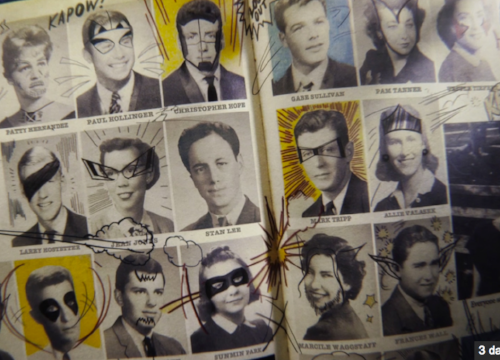
Stan Lee in Honda's new Super Bowl commercial
Lee's voice-over is based on his role at the center of the creation of the Marvel Universe:
"If you want to make a universe, make a universe!"
Other celebrities in the Honda ad include, among others: Robert Redford, Magic Johnson, Steve Carell, Missy Elliot, and Viola Davis.
If Lee looks exceedingly young in the photo, it is because he graduated from DeWitt Clinton High School in 1939, not yet 17-years old. Since he grew up in the tragic days of the Great Depression, Lee's mother Celia pushed him to skip grades so that he could graduate and enter the workforce.
Soon after graduation, Lee joined Timely Comics. Within a year, the young man became its defacto editor-in-chief (though he didn't use that title) and art director, despite the fact that he was still a teen.
The urge to work and help his family in a time of need explains how the man behind Marvel got his start. The comic book world, and later American popular culture, would never be the same...
January 4, 2017
Stan Lee Mini-Bust: Collectible at the American Heritage Center, University of Wyoming
The American Heritage Center (AHC) is a unique library and archive at the University of Wyoming in the unique Western town of Laramie. AHC is the university’s repository of manuscript collections, rare books, and university archives. One of its many fine collections focuses on the Comic Book Industry.
The Comic Book Industry collection is “unique in documenting the editors and writers of this industry increasingly recognized by scholars as having significant impact on the nation’s popular culture.”
One of the most noteworthy collections at AHC is the Stan Lee Papers (others include Private Snafu writer/editor Harold Elk Straubing and Superman editor Mort Weisinger). The Stan Lee collection is a seemingly endless archive of Lee’s work at Marvel, particularly strong in the era from the 1940s to 1970s. The Stan Lee Papers contain a wide range of documents and items, not just papers, though the archive has box after box of Lee’s business correspondence, fan mail, and Marvel internal memos. There are countless audio and videotapes, for example, that would take a researcher weeks to examine.
Since most fans and Marvel aficionados will never get the chance to visit AHC, over the next year I will share some of the unique findings I uncovered.

Stan Lee Mini-Bust, Stan Lee Papers, American Heritage Center, University of Wyoming
The Stan Lee figurine is one of the interesting pieces among the Stan Lee Papers.
According to WizardUniverse.com:
“Bowen Designs immortalizes the father of the Marvel Universe as this 5” tall collector’s bust! Sculpted by the master, Randy Bowen, the Stan Lee Mini-Bust is scaled to the rest of Bowen’s Marvel busts! What can we say, except “Excelsior, True Believers!” Painted and ready to display.
Sculptor Randy Bowen founded Bowen Designs in 1992 and quickly gained fame for his Marvel collectible statues.
The Stan Lee Mini-Bust sold for $45 in January 2003 with only 1,500 available. Some 14 years ago the figurine would have been a great investment. Recently on eBay, the mini-bust ranged from $175 to a signed statuette for $500.
December 30, 2016
The Year of Stan Lee
Stan Lee is undoubtedly one of the most important creative icons of the last century. His accomplishments are virtually unparalleled in modern popular culture, particularly when examining his entire career (beginning in the late 1930s and carrying through to the present).
Begin making a list of comparable artists and pop culture icons and you may have trouble finding a dozen like Lee over the last 100 years. Working across parts or all of nine decades, Lee’s longevity alone places him in rare air.
Simply gauged: Lee’s influence on popular culture touches most Americans on a daily basis.
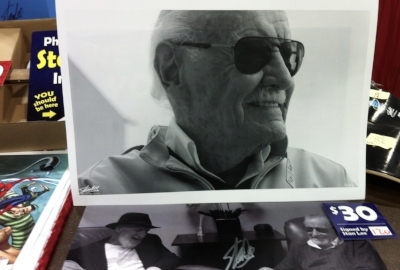
Image of the Stan Lee Collectibles Booth at the Cincinnati Comic Expo, September 24, 2016
To commemorate Lee and his significance as a contemporary pop culture icon, I am dedicating this blog to chronicling his life, career, successes, and challenges. Beginning with Lee’s 94th birthday on December 28, 2016, and running for at least the following year, I will bring readers highlights from the amazing, stupendous, and MARVEL-ous career of Stan “the Man” Lee.
My hope is that by examining Lee’s incredible life and work that readers will gain a more complete picture, as well as greater insight into why Lee’s career has been so important.
So, as Stan might say: “Excelsior!” Here’s to a fun ride… ‘Nuff said…
December 29, 2016
5 Reasons to Love Stan Lee

Stan Lee’s birthday on December 28 gave fans a reason to contemplate his place among the world’s most significant creative icons. It is easy to argue that the ideas Lee and his co-creators brought to life in Marvel superhero comic books are at the heart of contemporary storytelling.
Lee created a narrative foundation that has fueled pop culture for nearly six decades. While countless shelves have been filled with books about comic book history and those responsible for originating this uniquely American form of mass communication, there are still many reasons to examine Lee’s specific role.
Lee created a narrative foundation that has fueled pop culture for nearly six decades.
History and context are important in helping people comprehend their worlds. New comic book readers and ardent filmgoers who turn out in droves to see Marvel Universe films should grasp how these influences impact their worldviews.
Here are five reasons to love Stan Lee:
5. Fandom
In the 1960s and 1970s, no matter the tiny hamlet, thriving city, or rural enclave, if a kid got their hands on a Marvel comic book, they knew that they had a friend in New York City named Stan Lee. Each month, like magic, Lee and the Mighty Marvel Bullpen put these colorful gifts into our hands (in my youth in the 1970s, showcasing the ever-present “Stan Lee Presents” banner), which enabled us to travel the galaxies along with Thor, Iron Man, the Avengers, and X-Men.
Crisscrossing the nation speaking at college campuses, sitting for interviews, and speaking to readers in the “Stan’s Soapbox” pages in the back of comic books, Lee paved the way for intense fandom. His work gave readers a way to engage with Marvel and rejoice in the joyful act of being a fan. Geek/nerd culture began with “Smilin’ Stan” and his Merry Marauding Bullpen nodding and winking at fans each issue. Lee’s commitment to building a fan base took fandom beyond capitalistic sales figures and consumerism to creating communities.
4. Vision
While many comic book experts and insiders worried about monthly sales figures and demographics, Lee understood that Marvel’s horde of superheroes could form the basis of a multimedia empire. Ironically, he talked about turning Marvel into the next Disney decades before Walt’s company gobbled up the superhero shop. Back then, Lee’s idea drew derision and people openly scoffed at such a notion.
Lee saw the pieces of a multimedia empire and relentlessly pursued this vision, almost singlehandedly pushing Marvel as a film and television company. Lee championed superhero films and television shows in the mid-1960s and through the 1970s when Hollywood producers couldn’t fathom someone like Spider-man, Thor, or Iron Man appealing to a mass audience. It took Star Wars and Christopher Reeves’s Superman to show Tinseltown what movies could be.
3. Leadership
One of the most important aspects of creating comic books is that the process requires all-encompassing teamwork, from plot creation through distribution. While a great deal of work takes place alone, like an inker working page-by-page, much of the effort is coordinated and intricate.
At Marvel, really from the time Lee took over as editor as a teenager in 1941 until the boom in the early 1960s, he managed the artistic and production aspects of the company, simultaneously serving as art director, chief editor, and head writer. Much of the scholarly and critical commentary has centered on the controversy regarding Lee’s role as creator or co-creator of the iconic superheroes, but without similar focus or discussion about how he managed these other aspects. Artists Jack Kirby and Steve Ditko were phenomenal talents, but in contrast to Lee, they focused on one part of the production process. Lee directed, managed, or supervised it all.
2. Tenacity
In the early 1960s, most people looked down on the comic book industry and the creative teams that produced comics. Suffering from bouts of frustration and despair, Lee couldn’t stomach working in comics any longer. He warred with the idea of chucking his more than 20-year career versus bringing home the steady paycheck that Marvel’s mediocrity delivered. “We’re writing nonsense…writing trash,” he told his wife Joan. I want to quit, he confided: “After all these years, I’m not getting anywhere. It’s a stupid business for a grownup to be in.”
Yet, when Marvel publisher Martin Goodman suggested he mimic DC and create a superhero team, Lee took a risk on a new kind of team, heroes who had their superpowers foisted on them and didn’t hide from their real human emotions. The Fantastic Four gave Lee the chance to explore a new type of hero and fans responded. Lee didn’t quit. The Marvel Universe was born.
1. Transforming Storytelling
Lee’s legacy is undeniable: he transformed storytelling by introducing generations of readers to flawed heroes who also dealt with life’s everyday challenges, in addition to the treats that could destroy humankind.
Generations of artists, writers, actors, and other creative types have been inspired, moved, or encouraged by the Marvel Universe he gave voice to and birthed. Lee did not invent the imperfect hero, one could argue that such heroes had been around since Homer’s time and even before, but Lee did deliver it – Johnny Appleseed style, a dime or so a pop – to a generation of readers hungry for something new.
The Fantastic Four transformed the kinds of stories comic books could tell. Spider-Man, however, brought the idea home to a global audience. Lee told an interviewer that he had two incredibly instinctive objectives: introduce a superhero “terribly realistic” and one “with whom the reader could relate.” While the nerd-to-hero storyline seems like it must have sprung from the earth fully formed, Lee gave readers a new way of looking at what it meant to be a hero and spun the notion of who might be heroic in a way that spoke to the rapidly expanding number of comic book buyers. Spider-Man’s popularity revealed the attraction to the idea of a tainted hero, but at the same time, the character hit the newsstands at the perfect time, ranging from the growing Baby Boomer generation to the optimism of John F. Kennedy’s Camelot, this confluence of events resulting in a new age for comic books.
December 28, 2016
Stan Lee's Birthday!

Happy Birthday Stan Lee Facebook Page
December 25, 2016
Celebrate Stan Lee's 94th Birthday!

June 27, 2016
Who is Don Draper?
An excerpt from Mad Men: A Cultural History (Rowman & Littlefield, 2016) by M. Keith Booker and Bob Batchelor
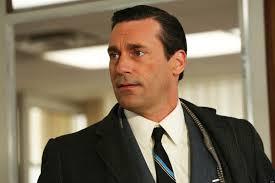
"What you’re watching with Don is a representation, to me, of American society. He is steeped in sin, haunted by his past, raised by animals, and there is a chance to revolt. And he cannot stop himself.”
-- Matthew Weiner, 2014
Don Draper is a hero and villain. The things he worships – California, cars, self-worth, movies, lasting accomplishment – symbolize postwar America in an age when the nation’s power seemed unbounded. Draper, too, is a study in paradox, which essentially serves to make him even more profoundly American. In creating this character, Matthew Weiner forces viewers to reflect on Draper’s life and deeds (good and bad) by showing that aspects of him are in us all – a true everyman for the modern world.
The extremes are always just below the surface with Don. He can lose control in an instance. Draper is also capable of deep compassion. There are bouts of terrifying malevolence. Often, his contempt for the shackles of the corporate world and advertising business forces him to flee, as if one more moment at his desk or in a meeting will yank his soul into eternal damnation. Yet, at the same time, his zeal for what he calls, “the work” and the creative spark that wins him fame and fortune rarely wavers. These dualities create a character that exudes everything that is righteous and strong about the American Dream – a kind of Superman in a suit – but one that also typifies the nation’s ugliness. As a result, there is no easy way to answer this chapter’s title question. Instead, the judgment is pieced together by interrogating both the subtle nuance and audacious bluntness Draper embodies.
Similar to other outstanding fictional characters across film, literature, and television, Draper is timeless. He symbolizes our own era, even as he is meant to typify the chaotic 1960s. Yet, he is not simply a televised version of John Updike’s Harry “Rabbit” Angstrom, Don Corleone, Bob Dylan, Sloan Wilson’s man in the gray flannel suit, Saul Bellow’s Augie March, or Batman. He is representative, but also unique, which is at least in part why audiences are so attracted to him, despite his reprehensible traits. Viewers can see “real life” in Don (traits of their family members and friends), but also those drawn out of the fictional world, from suave characters played by Cary Grant to the real or imagined John F. Kennedy.
Draper is a composite of ideas, actions, and impulses that audiences have proven to relish across American popular culture for decades. Like F. Scott Fitzgerald’s Jay Gatsby, for example, Don is mysterious and has difficulty attuning his two lives after assuming a new identity. Physically, Draper projects the “leading man” looks and toughness of Hollywood stars, like real-life icons Clark Gable and Gregory Peck. In playing Don, Jon Hamm flashes the same tough/tender and realist/idealist persona that many of the golden age film actors emanated. The “tough, but sensitive” personality, combined with traditional male beauty, draws viewers to the Draper character, because we feel his quest, the unyielding existential angst. He is reaching for greatness, but lassoed to the here and now, essentially waging warfare between these competing proclivities.
As a character, Don Draper asks audiences to contemplate his fictional life with the impulses and ideas that power the contemporary world: what role does sexism play in modern society, how much alcohol is too much, how do we treat friends and family, how might we interpret our coworkers and bosses, can we outrun the past, is the future bright. There is no doubt that some viewers take pleasure in the bad boy side of Draper’s personality, particularly with booze, cars, women, and cigarettes. As the character both suffers and rejoices over seven seasons, people acquire the context to add value to their own ideas about life, the past, and avenues toward the future. The framework that Weiner created not only makes Draper an important character in television history, but also provides the show with lasting importance.
April 6, 2016
Loving (and Hating) Rolling Stone
Rolling Stone is awesome and awful.
In the 1980s, growing up anywhere outside a major city meant limited -- or virtually zero -- access to things deemed cool. Rolling Stone provided a much-needed spiritual link to the world outside suburban or rural America, then dominated by cookie-cutter record stores and mainstream culture crafted in corporate boardrooms. Many small towns would not even allow MTV onto the ultra-conservative cable systems run by characters quite similar to John Lithgow in Footloose.
In a world of stifling conformity, Rolling Stone brought culture to the hinterlands in a big, oversized package. It served as a lifeline. The magazine not only covered popular culture, but actually defined culture in those pre-web days. Rolling Stone felt like contraband, passed around and through various high school cliques. That glimpse into the larger world seemed priceless.
Looking back, Rolling Stone provided culture-starved readers two things they could not get anywhere else: a portrait of artists as human beings, and because the covers and photographs were so good, the power of visual culture. We learned about R.E.M. and U2 via Rolling Stone and waited for the “Yearbook” and “Hot” issues to relish in the joys of the best photography we had ever seen.
In college, all these kids passing around Rolling Stone were tacking covers up on walls. Many images grew into iconic photos representing the age -- nearly naked Janet Jackson in black and white or the Nirvana album cover announcing a new sheriff in town about to wipe out hair metal and its inauthentic excesses.
Hating Rolling Stone is tough.As an adult, reading Matt Taibbi on the Iraq War, its insider coverage of Great Recession wrongdoings, or historian Sean Wilentz’s celebrated takedown of President George H.W. Bush as the worst to ever hold the office provided new insight into the most important topics the nation faced. At the same time, though, these pieces and many more like them seemed to have little or no dent on the national conversation.
Back in all those small towns, Fox News, Rush Limbaugh, and conservative talk radio won the hearts and minds by railing against the kinds of things Rolling Stone seemed to embody. The magazine continued to preach to people already onboard with its agenda, its readers willingly surrendered the media battlefield to conservative forces. Rolling Stone did not rally people to stand up to the other side, which aggressively fought for the middle of the nation.
Losing relevance is one thing, but the many high-profile scandals takes Rolling Stone loathing to a different level. “A Rape on Campus,” published in November 2014 set off a nationwide uproar regarding sex crimes on college campuses, and sparked a much-needed dialogue. As a result, countless institutions set up new systems for reporting and dealing with these challenges. Yet, over the next several months, the story unraveled as The Washington Post and Charlottesville police determined that the gang rape never occurred. The hoax, which seems to have been an elaborate catfishing plot by the accuser, forced Rolling Stone to retract the story and apologize. The fabrication also set off a series of lawsuits that will keep the magazine in the news for all the wrong reasons for years to come.
Although lurching from 18 months of bad publicity, Rolling Stone again hit a nerve when it allowed actor/activist Sean Penn to secretly meet with and interview notorious fugitive/drug lord Joaquin “El Chapo” Guzmán. After a fierce gunfight, drug officials caught El Chapo prior to the long article running in Rolling Stone, but its seemingly empathetic tone thrust the magazine back into the negative spotlight.
The interview lit up social media, with heavy doses of mockery for Penn and the magazine, while journalists and journalism scholars debated the magazine’s willingness to run the piece and the ethical implications. The latter centered on Rolling Stone editors allowing El Chapo to approve the piece before publication, a violation of one of journalism’s most sacred tenets. Editor/publisher Jann Wenner seems to dismiss such criticism, despite the bad consequences he and the magazine he co-founded in 1967 faces.
Though not as nefarious as the big scandals, there is another reason to frown on the magazine’s influence on modern American journalism – the Rolling Stone-style profile. The RS “formula” is almost instantly recognizable: a mix of insider portrait/anecdote, gossip, astute observation, and snarky commentary. The pervasiveness of the too-cool-for-school voice is a stalwart of entertainment reporting. My reaction to the model is that it can be either a.) somewhat humorous, or b.) provoke an I-just-threw-up-a-little-in-my-mouth moment.
"The Rolling Stone-style profile. The RS “formula” is almost instantly recognizable: a mix of insider portrait/anecdote, gossip, astute observation, and snarky commentary. The pervasiveness of the too-cool-for-school voice is a stalwart of entertainment reporting."
Rolling Stone’s coverage of David Bowie following his recent death provides good examples of the RS formula. For example, Brian Hiatt’s “The Final Years,” begins with an on-the-scene portrait of Bowie seemingly experiencing his first major health crisis, the 2004 heart attack while on stage in Prague. This kind of breathless insider info, even covering the profile’s internal thinking (“he found himself struggling for breath”), is now routine in entertainment pieces. We see this in the almost mandatory description of where the reporter and interviewee met for lunch and what he or she ate and wore.
Mikal Gilmore’s profile of Bowie’s life and influence is even more formulaic, bouncing between solid criticism and too-smart-by-half interjections purposely designed to establish the writer’s superiority over the uncultured, unknowing reader. In discussing the singer’s The Man Who Sold the World (1970), Gilmore astutely explains it “was a strange, paranoid and philosophical album. Bowie was now working largely in electric rock & roll -- hard and dissonant, and not quite like anybody else’s.”
However, the RS formula necessitates that commercial success be downplayed at the expense of “artistic” work. Gilmore calls Bowie’s post-Let’s Dance (1983) global superstardom “a confusing creative trail” that resulted in “indifferent-sounding albums…that met with little esteem.” For Gilmore, the singer redeems himself after Black Tie White Noise (1993), which led to “a series of ambitious, occasionally brilliant, albums.”
The conundrum seemingly always on hand for Rolling Stone writers is how to tone down the thing that makes an entertainer popular, which is the reason they are being profiled, while also balancing the insider snapshots and snarky criticisms. Because the magazine gained wide popularity in the 1960s and 1970s, when many journalism professors studied or were working professionals, they have passed this formula down to two generations of writers. The result is a wildfire of mechanical pieces all within the Rolling Stone guise. Very little is gained or learned, because the formula demands little of the writer or subject. It’s not writing; it’s patchwork. Unfortunately, the formula is now at the center of all entertainment -- we see it in reality television and many mainstream films and novels. There is little to challenge the audience, because the formula is ubiquitous.
Rolling Stone stands at a crossroad for many readers. Is it possible to stay in love with a magazine that meant so much, but now seems to be slipping out of touch? For countless readers, Rolling Stone helped create and construct a worldview and provided something that at one time seemed exotic and exciting. Perhaps it is time to throw it out with the nostalgic bathwater.



